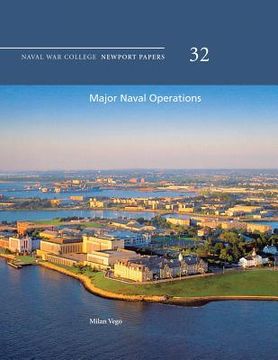Reseña del libro "Major Naval Operations: Naval War College Newport Papers 32 (en Inglés)"
Naval history as generally recounted is a story of battles at sea. However, it has to be admitted that since 1945 neither the United States nor any other contemporary naval power has had much of a naval history in this sense. Domination of the oceans by the United States and its allies, together with the fortunate failure of the Cold War to culminate in a test of strength between the American and Soviet navies, meant that classic naval battle gradually faded from center stage in the education and professional orientation of American naval officers. Beginning in the early years of the Cold War, the Navy became preoccupied largely with technology and the tactical proficiency that rapidly advancing naval and weapons technologies made increasingly necessary. At the extreme, of course, the advent of nuclear weapons seemed to many to leave the Navy little role in a major global conflict other than to provide invulnerable launch platforms for these weapons-and thereby a powerful deterrent that would, as it was thought, obviate their actual use. Beyond that, though, the switch to nuclear propulsion for the Navy's capital ships laid heavy technical demands on new generations of naval officers, with concomitant impact on their education and training. The result-or so contends Milan Vego in On Major Naval Operations, the thirty-second volume in the Naval War College Press's Newport Papers series-has been a long-standing neglect by the U.S. Navy of major naval operations and, more broadly, of the "operational" level of war or of naval "operational art." The term "operational art" is apt to be unfamiliar to most Americans. American military officers encounter it routinely as a fixture of contemporary joint military doctrine, but even today the concept has substantially less traction within the U.S. Navy than it does in the other services. The reason is plainly that its origins are in land warfare-specifically, in large-scale land warfare as theorized by the German and (especially) Soviet militaries during the interwar period and practiced by these countries in World War II. From the latter, it migrated to the U.S. Army in the late 1970s, as the Army sought novel ways to grapple with the increasingly formidable prospect of a Soviet ground assault against Western Europe. Essentially, "operational art" refers to a level of command intermediate between the tactical and the strategic, one associated with ground command at the level of field army or corps and with the conduct of "campaigns" that unfold as a series of interconnected battles over time. That many naval officers remain unconvinced of its applicability to their own domain is not surprising, given the narrowly tactical focus of much naval warfare of the past. (Wayne Hughes's classic treatise Fleet Tactics, for example, begins by dismissing the utility of the concept of operational-level warfare for naval combat.) On the other hand, it is difficult to deny that naval command and control doctrine and practice today are insufficiently attentive to what in Army parlance would be called a "combined arms" approach to warfare. The tenuous relationship between the three principal naval warfare communities remains the strongest argument for a serious reconsideration by the Navy of major naval operations and operational art. Dr. Milan Vego is a professor in the Joint Military Operations Department of the Naval War College. He has published widely on the history of German and Soviet military doctrine, and he is the author of Operational Art (2001) and Joint Operational Warfare (2008), an authoritative textbook currently utilized in the department's curriculum. In this work, he looks back to the richly instructive experience of the U.S. Navy in World War II (as well as in more recent operations during the Korean and Vietnam wars and in the Persian Gulf) in order to develop a taxonomy of naval operational art that can help inform the thinking of the Navy as a whole today.

